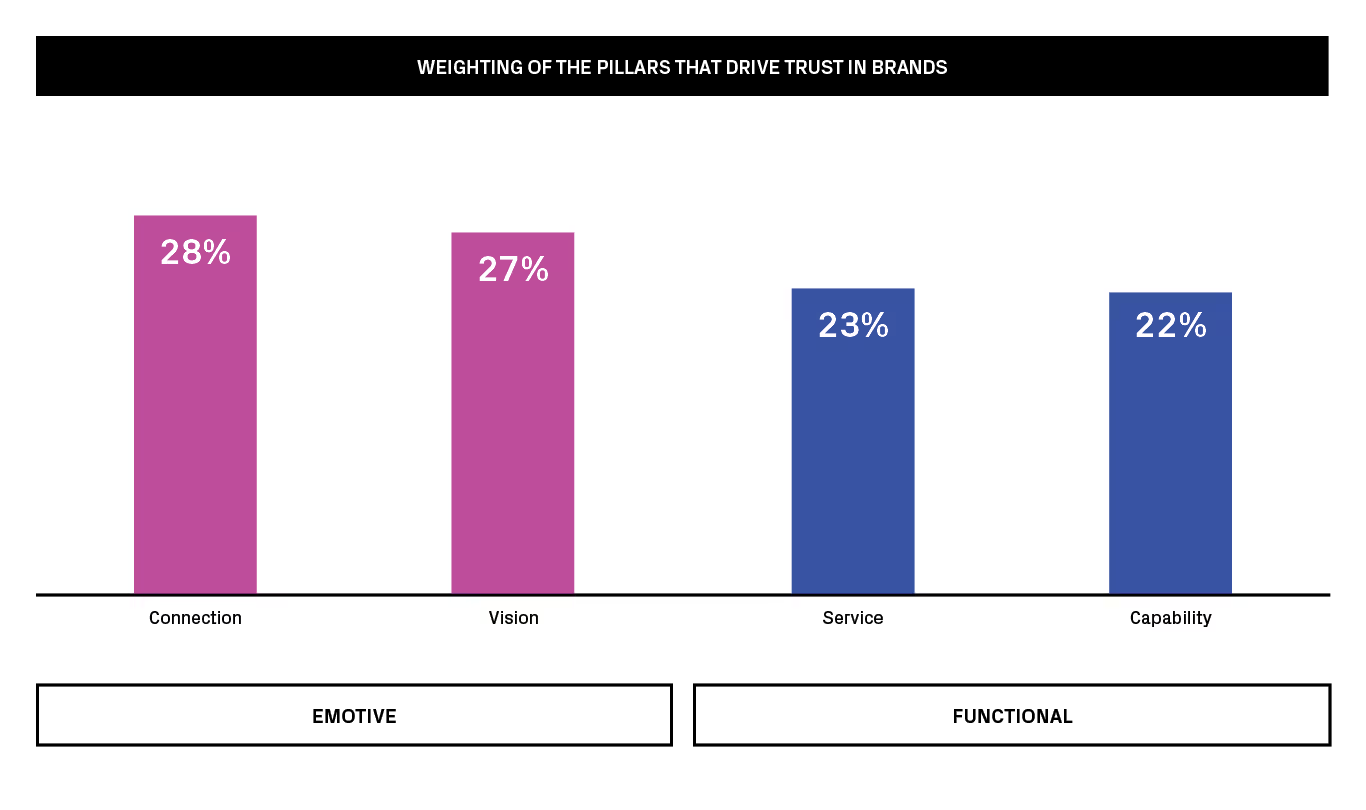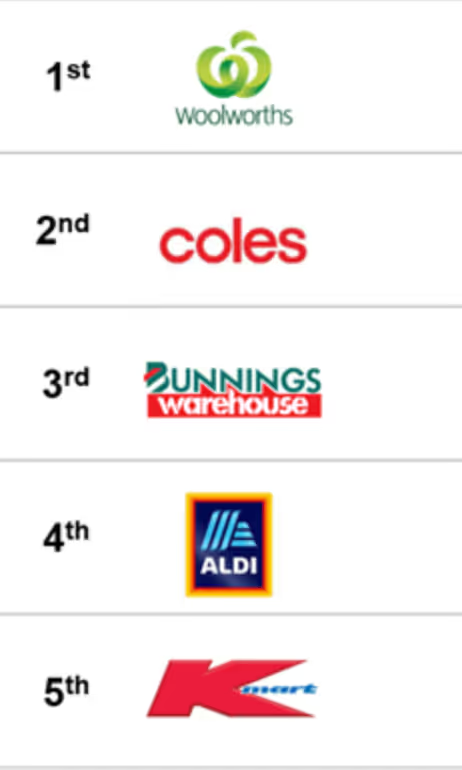
Menu

Trust is a profound human feeling. It’s the bedrock of our interactions – how we can live together, collaborate, trade and share resources.
In marketing, we know that when people trust a brand there is a halo effect. People are more likely to like the brand, favour it when buying decisions are made, and forgive errors. Humans feel first and think second, which is why the presence or absence of a feeling of trust influences our behaviour.
Brands benefit from people’s underlying baseline of trust. In recent history people’s default position has been to trust until proven otherwise. Though not anymore, according to the latest Edelman Trust Monitor data, showing distrust is now the default mode for more than fifty percent of people.
What does that mean for organisations and how they deliver their products and services? It means brands have to work harder to earn trust through brand experiences.
In our personal lives it’s clear why trusting our friends and colleagues would make us feel good, but does it matter if we trust brands and the organisations we engage with?
Well, would you buy from a brand you didn’t trust? Of course not.
In late 2021, TRA interviewed 4000 New Zealanders about trust in relation to brands and found a very high correlation between trust and brand love (a proxy for feeling warmly toward the brand). Brand love in turn has a strong correlation with consideration and brand choice.
A customer’s level of trust in the brand is like a tinted lens which sets expectations, and the result can be that an identical experience with two different brands can result in different levels of satisfaction. If you are more trusted the expectation bar is set higher for you to reach an acceptable level of satisfaction.
But, trust creates a positive mindset. This means they are more likely to overlook minor glitches. Trust, essentially, gives the brand the benefit of the doubt.
Different parts of our brain activate when we think about brands as a concept, versus when we engage in a real-life experience.
At the brand level we are dealing with associations, unconscious processing of brand communications or reputational cues – in neuroscience terms, the prefrontal cortex, which is where we process intangible concepts like brands.
Customer experience tends to excite a different bit of our brain because we’ve evolved to treat experiences as both a risk and an opportunity. New experiences put us on alert, our amygdala activates and we feel anxiety. In short, we don’t like uncertainty, but if we didn’t embrace it we’d never find new opportunities. So dopamine rewards us with nice feelings like anticipation and reward.
Between brand and customer experience are connective emotional associations which have a huge impact on how the feeling of trust permeates across our holistic brand experience.
In short, brands and organisations must signal trust both at the brand level and the customer experience level.
We did a deep dive into what factors drive high trust in a brand and found they include more emotive and tangible factors.
To build trust takes time and both the brand's past and future have a role to play. If a brand has been around a long-time people tend to trust it. It wouldn’t have survived this long if it wasn’t trustworthy. So, heritage has inherent trust credentials, but so does having a vision for the future.
A vision creates confidence in how that entity will behave in the future. Stating where you are going is a declaration that you are in control – and that’s a characteristic that builds trust. Vision creates confidence and trust. Vision includes things like innovation, articulating the brand’s vision through all levels of communication (not just a statement on the corporate office wall), and taking a position on sustainability for the business and society.

One example is Air New Zealand, which scores well on Vision and Service. This is a remarkable turnaround after the problems it suffered in the immediate period of the Covid lockdown when it had no way of issuing credits for cancelled flights. It is a good example of how your history can work for you and how laying out a vision for the future can increase trust.
Then, between your history and your future there is how you turn up today; what you say, how you say it, and what you do. For example providing customers with the opportunity to have input which is recognised and reflected. And showing transparency when communicating with people.
CBA (Commonwealth Bank of Australia) worked with researchers from Harvard Business School to understand if transparency was good or bad when people were choosing credit cards. A split sample showed people either only the benefits of the card or the upside and the downside. They found that people who opened an account after learning about a card’s downsides spent 10 percent more each month than customers who heard only the benefits. Their nine-month cancellation rate was also 21 percent less.
The more tangible factors of service and capability are grounded in a brand’s knowledge and ability to consistently deliver quality and responsiveness. People aren’t experts in your field so they want to trust you to have the right products/services to meet their needs. From a service perspective they want to be able to depend upon you. They want to trust you to be responsive.
Between the more emotive aspects of trust and the tangible levels of trust there is a mismatch of what matters to people and what brands do well.
It’s useful to look at trust in this way because it can show the levers that can be pulled to improve a brand’s trust. For example, when we looked at New Zealand’s most trusted brands, they performed differently across these different elements.


Whittakers score well on trust overall and top the chart for Vision. By comparison, Mitre 10 is a very trusted brands, achieving a high score on the more tangible pillars of Service and Capability. (Mitre 10 does not do badly on the more emotive pillars. To get a high score overall requires achieving a good enough score on all the pillars.) Pak ‘n Save also scored highly on Capability (tangible) and Connection (emotive) scores.
It is interesting looking at similar research in Australia that retail brands attract high trust scores. A Roy Morgan study in 2021 had retail brands in the top five slots for trusted brands. The role that retailers played through Covid lockdowns will have played a part in this.

We mentioned earlier how different parts of our brain are active for the mental imagery we have of a brand as a concept versus when we engage in a real-life experience.
Emotions and feelings wash over everything. Conceptual constructs like brands evoke an emotional response – how we feel as we approach an experience. Our feelings about the experience are then coded in our memories. Feelings in the future trigger the memory of past experiences. The point is that there is a connective association and that it has a huge impact on how the feeling of trust permeates across our holistic brand experience.
There is only one way to build trust well and that is by being consistent across brand and customer experience.
Distrust as a default presents a challenge for marketers. Every brand needs a set of trust signals that span the brand's vision, narrative and communications, how it shows it is listening to its audience and how it turns up as a total brand experience.
In the United Kingdom in the 1960s, New Zealand author Fay Weldon coined the phrase “Got to work on an egg” which led an entire generation to trust eggs as a nutritional start to the day. No one questioned the facts. A catchy slogan was enough to imbue trust. When they tried to revive the campaign a decade later, they weren’t allowed to because an egg is not an adequate breakfast to go to work on. Who knew!
These days a catchy slogan is only one aspect of creating trust at a brand level. The difference today is the added challenge of signalling trust throughout the whole brand experience to an audience ready to call you out.
Whatever you think of Steve Jobs, his statement that “a brand is simply trust” was a challenge that Apple delivered to its devoted customers. The brand, the product, the user experience; all aligned. No one doubted that their expensive Apple product would work straight out of the box, with no requirement to read a 40-page instruction booklet, and that Apple would understand how they wanted to use their fingers to interact with screens. People simply trusted.